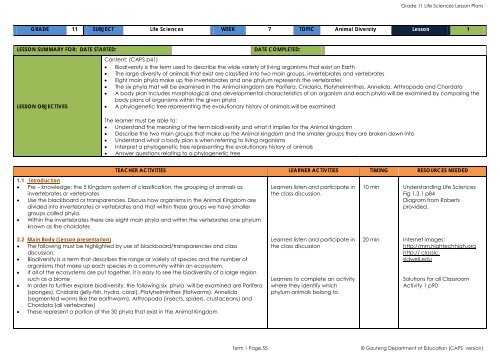Life Science Grade 11
Life Science Grade 11
Life Science Grade 11
You also want an ePaper? Increase the reach of your titles
YUMPU automatically turns print PDFs into web optimized ePapers that Google loves.
<strong>Grade</strong> <strong>11</strong> <strong>Life</strong> <strong>Science</strong>s Lesson PlansGRADE <strong>11</strong> SUBJECT <strong>Life</strong> <strong>Science</strong>s WEEK 7 TOPIC Animal Diversity Lesson 1LESSON SUMMARY FOR: DATE STARTED:LESSON OBJECTIVESDATE COMPLETED:Content: (CAPS p41)• Biodiversity is the term used to describe the wide variety of living organisms that exist on Earth• The large diversity of animals that exist are classified into two main groups, invertebrates and vertebrates• Eight main phyla make up the invertebrates and one phylum represents the vertebrates• The six phyla that will be examined in the Animal kingdom are Porifera, Cnidaria, Platyhelminthes, Annelida, Arthropoda and Chordata• A body plan includes morphological and developmental characteristics of an organism and each phyla will be examined by comparing thebody plans of organisms within the given phyla• A phylogenetic tree representing the evolutionary history of animals will be examinedThe learner must be able to:• Understand the meaning of the term biodiversity and what it implies for the Animal kingdom• Describe the two main groups that make up the Animal kingdom and the smaller groups they are broken down into• Understand what a body plan is when referring to living organisms• Interpret a phylogenetic tree representing the evolutionary history of animals• Answer questions relating to a phylogenetic treeTEACHER ACTIVITIES LEARNER ACTIVITIES TIMING RESOURCES NEEDED1.1 Introduction• Pre – knowledge: the 5 Kingdom system of classification, the grouping of animals asinvertebrates or vertebrates• Use the blackboard or transparencies. Discuss how organisms in the Animal Kingdom aredivided into invertebrates or vertebrates and that within these groups we have smallergroups called phyla.• Within the invertebrates there are eight main phyla and within the vertebrates one phylumknown as the chordatesLearners listen and participate inthe class discussion.10 minUnderstanding <strong>Life</strong> <strong>Science</strong>sFig 1.3.1 p84Diagram from Robertsprovided.2.2 Main Body (Lesson presentation)• The following must be highlighted by use of blackboard/transparencies and classdiscussion:• Biodiversity is a term that describes the range or variety of species and the number oforganisms that make up each species in a community within an ecosystem.• If all of the ecosystems are put together, it is easy to see the biodiversity of a large regionsuch as a biome• In order to further explore biodiversity, the following six phyla will be examined are Porifera(sponges), Cnidaria (jelly-fish, hydra, coral), Platyhelminthes (flatworms), Annelida(segmented worms like the earthworm), Arthropoda (insects, spiders, crustaceans) andChordata (all vertebrates)• These represent a portion of the 30 phyla that exist in the Animal KingdomLearners listen and participate inthe class discussionLearners to complete an activitywhere they identify whichphylum animals belong to.20 minInternet images:http://mm.hightechhigh.orghttp:// classic.sidwell.eduSolutions for all ClassroomActivity 1 p90Term 1 Page 55© Gauteng Department of Education (CAPS version)







